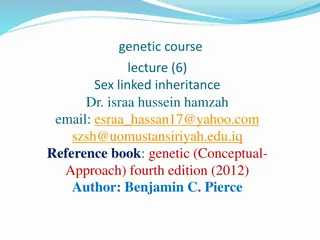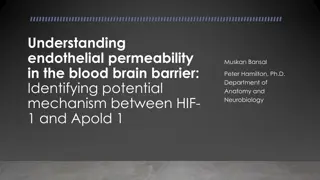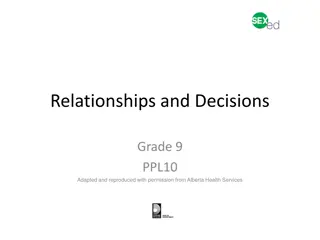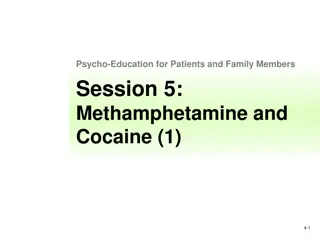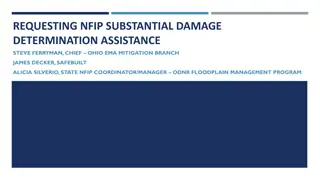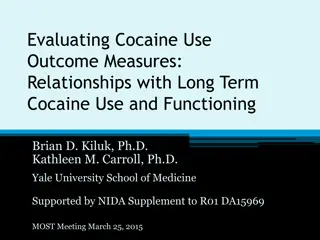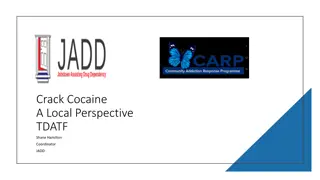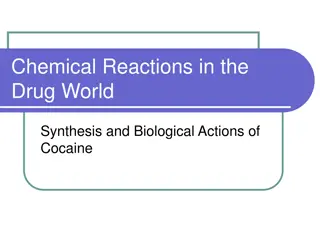Lowered Endothelial Damage in African Americans Linked to Cocaine Abstinence
Cocaine use is a significant public health concern in the US, affecting many communities. A preliminary study by Johns Hopkins School of Medicine suggests that abstaining from cocaine and reducing its use may lead to decreased endothelial damage in African Americans. FDA has not approved medications for treating cocaine addiction in humans, although studies show promise in reducing intake. The FDA emphasizes the importance of sustained abstinence in treating cocaine abuse and seeks clinical metrics beyond just cocaine use to assess health and behavioral benefits. Research with support from NIDA is ongoing in Baltimore to study subclinical coronary artery disease in African Americans with and without cocaine use over a 14-year period.
Download Presentation

Please find below an Image/Link to download the presentation.
The content on the website is provided AS IS for your information and personal use only. It may not be sold, licensed, or shared on other websites without obtaining consent from the author.If you encounter any issues during the download, it is possible that the publisher has removed the file from their server.
You are allowed to download the files provided on this website for personal or commercial use, subject to the condition that they are used lawfully. All files are the property of their respective owners.
The content on the website is provided AS IS for your information and personal use only. It may not be sold, licensed, or shared on other websites without obtaining consent from the author.
E N D
Presentation Transcript
Cocaine Abstinence and Reduced Use are Associated with Lowered Endothelial Damage in African Americans: A Preliminary Study Shenghan Lai Johns Hopkins School of Medicine
Background Cocaine use is a serious public health problem that affects almost every community in the US. The number of persons aged 12 or older who were current users of cocaine in 2013 is approximately 1.5 million (http://www.drugwarfacts.org/cms/Drug_Usage# sthash.fWJEI90u.dpuf).
Background A NIDA-funded study in rats shows that using a combination of buprenorphine and naltrexone reduces cocaine intake without producing opioid dependence. However, FDA has not approved any medication for treating cocaine addiction in humans (http://www.drugabuse.gov/news-events/news- releases/2012/08/combined-medication-shows-promise-treating- cocaine-addiction).
Background FDA accepts self-reported number of heavy drinking days as a primary endpoint for alcohol- related clinical trials, however, for medications treating cocaine abuse, FDA s bar is much higher: a period of abstinence that lasts through the end of treatment (Skolnick P, Volkow ND. Addiction therapeutics: obstacles and opportunities (Biol Psychiatry. 2012;72(11):890-1).
Background The FDA believes that cocaine use behavior is only a surrogate indicator for risks of health or behavioral problems, and that a clinical metric reflecting sufficient behavior change beyond cocaine use is needed to reasonably conclude a probable benefit in health and behavior domains (Donovan DM, et al. Primary outcome indices in illicit drug dependence treatment research: systematic approach to selection and measurement of drug use end-points in clinical trials. Addiction. 2012 Apr;107(4):694-708).
Background With support from NIDA, we have enrolled and followed- up 1,500 African Americans in Baltimore for >14 years with a very low dropout rate (<3.5% per year) to investigate subclinical CAD in people with and without HIV infection, and with and without cocaine use. In addition to imaging data from contrast-enhanced coronary CT angiography (CTA) and MRI, we also collected behavioral, demographic, medical, clinical, and laboratory data and biological specimens over time. The data from our 14-year studies are invaluable for investigating the health risks and behavioral problems associated with cocaine use.
Background For example, based on Poisson regression analyses (N=1429), after adjustment for the 2013 ACC/AHA cardiovascular risk, cocaine use was significantly associated with subclinical CAD (adjusted PR=1.25 with 95%CI;1.07,1.45, p=0.004). However, HIV infection was not (adjusted PR=1.01, 95%CI:0.86,1.19, p=0.94).
Objectives The current study, funded by NIDA has three objectives: to explore (1) whether cocaine abstinence leads to less endothelial damage, (2) whether cocaine abstinence retards coronary plaque progression, and (3) whether reduction in cocaine use leads to less endothelial damage in African American (AA) chronic cocaine users with contrast- enhanced coronary CT angiography (CTA)- confirmed <50% coronary stenosis.
Methods Between March and April, 2014, 38 AA chronic cocaine users (10 women and 28 men) were enrolled in this preliminary study.
Methods Inclusion criteria were (1) AA participants aged 25 years of our ongoing studies (both HIV+ and HIV-) with the presence of <50% non- obstructive coronary plaque at enrollment, (2) Chronic cocaine use: defined as use of cocaine by any route for at least 6 months, administered at least 4 times a month, and (3) Self-reported recent cocaine use, confirmed by a positive urine test for cocaine or benzoylecgonine during the initial screening interview.
Methods Exclusion criteria were (1) Any evidence of clinical CAD, (2) History of serious physical disease or current physical disease, (3) Pregnancy, or at risk of pregnancy, (4) Chronic kidney disease with an estimated glomerular filtration rate of < 60 ml/minute/1.73 m2, and (5) Contraindication to CT scans, including a history of contrast allergy.
Methods The Committee on Human Research at the Johns Hopkins School of Medicine approved the study protocol, and all study participants provided written informed consent. All procedures used in this study were in accordance with institutional guidelines.
Procedures Interview, medical chart review, physical and laboratory examination All study participants underwent a baseline visit, including a detailed interview to obtain information about sociodemographic characteristics, medical history, behaviors, including alcohol consumption, drug use, and cigarette smoking, and medications. For HIV+, detailed information about HIV-related risk factors, duration of known HIV infection, and medications, was also collected. A medical chart review was done. The following laboratory tests were performed at baseline: total serum cholesterol, triglycerides, HDL, LDL, glucose, high-sensitivity CRP, and ET-1. Collection of all the above-mentioned baseline data was repeated at the 6-month follow-up visit.
Procedures Voucher-based Incentive Interventions The voucher-based incentive program utilized is a contingency management procedure that systematically reinforces cocaine abstinence, with features modeled after the escalating voucher incentive program developed by Higgins and colleagues (Higgins et al, 1993; Higgins et al, 1994). Under a voucher earnings procedure, points (each point = $1.00) were awarded for cocaine-negative urine test results with the number of points to be earned increases for each consecutive negative urine test.
Procedures Urine Benzoylecgonine Test Urine tests were scheduled in advance. Urine samples were collected under observation of a same-sex research assistant, and the temperature of the sample was examined to confirm its validity. Cocaine metabolite quantitation were conducted using Dip Card DOA 1 Panel Dip Card COC (MP Biomedicals, Solon, OH), which was a one- step urinalysis immunochromatography drug rapid test (5 minutes). It provided for qualitative screening of cocaine metabolite in human urine specimens and provided a preliminary analytical test result for on-site testing. The urine samples were also stored for further quantitative urine analysis (Preston et al;1997).
Procedures Contrast-enhanced Coronary CTA Coronary vessels were assessed for patency and stenoses using 3D visualization tools after the axial images were reviewed for determination of anatomy, quality of the study, and appearance of the vessels. Dr. Fishman, blinded to the participants risk factor profiles, independently evaluated the contrast-enhanced CTA scans. The coronary artery tree was segmented according to the modified AHA classification, and the segments were investigated for plaque and luminal narrowing. Calcified plaque was defined as a structure 1 mm2 in sizewith attenuation > 130 Hounsfield units (HU) visualized separately from the intravascular lumen, identified in at least 2 independent planes. Noncalcified plaque was defined as a low density area 1 mm2in size and with a CT density 130 HU, located within the vessel wall. Significant stenosis was defined as >50% diameter stenosis.
Results General Characteristics As of December 2014, the data of both 6-month follow-up CTA and all laboratory testing were available on 22 of the 38 participants. The demographic and clinical characteristics of these 22 study participants are presented in Table below. The median age was 56 years and 27% were women. Among the 22 participants, 21 were HIV infected. The median duration of cocaine use was 13 (IQR: 8-25) years. The median ET-1 was 2.07 (1.63,2.62) pg/mL. The median systolic BP was 120 mmHg (IQR: 108, 127) and the median diastolic BP was 72 mmHg (IQR: 61, 79). The median cardiovascular risk according to the 2013 ACC/AHA guidelines was 9.1 (IQR: 5.6-18.7). Thirty-six percent of participants had low cardiovascular risk according to the guidelines (Goff et al, 2014).
Table. Baseline Characteristics of 22 African American Study Participants in Baltimore, Maryland by Baseline ET-1 Characteristic Age (year) Male sex (%) Family history of heart attack (%) Cigarette smoking (%) Years of cigarette smoking Alcohol use (%) Years of cocaine use BMI (kg/m2) hsCRP(mg/dL) Systolic BP (mm Hg) Diastolic BP (mm Hg) Glucose (mg/dL) Total cholesterol (mg/dL) LDL-C (mg/dL) HDL-C (mg/dL) Triglycerides (mg/dL) Endothelin-1 (pg/mL) HIV infection 2013 ACC/AHA risk (%) Low 2013 ACC/AHA risk (%) Days of cocaine use within the 6 months Total (N = 22) 56(54-58) 72.7 36.4 86.4 30(20-35) 95.5 13(8-25) 28.4(22.6-33.3) 2.6(1.1-3.4) 120(108-127) 72(61-79) 89(84-96) 152(145-190) 76(48-104) 55(42-63) 120(84-160) 2.07 (1.63-2.62) 95.5 9.1(5.6-18.7) 36.4 7 (0-77)
Results Total abstinence from cocaine and reduction in cocaine use Among these 22 participants, 11 were abstinent from cocaine (6 months), while 11 continued to use cocaine. Among those who continued to use cocaine, 2 participants used every day based on urine tests. The distribution of cocaine use during the 6 months is presented in Figure below.
% of participants using cocaine and ET-1 at baseline and 6-month followup
Results Total abstinence from cocaine and reduction in ET-1 By univariate GEE analysis, cocaine abstinence for 6 months was significantly associated with lower ET-1 (p=0.004). After controlling for family history of heart attack, baseline ET-1, and 2013 ACC/AHA cardiovascular risk, total abstinence from cocaine remained significantly associated with decreased ET-1 (p<0.0001) (Table below).
Table. Effects of total abstinence and other factors on ET-1 GEE analysis (square-root ET-1: outcome variable) Univariate model Multivariate model Factor Regression Coefficient S.E. P-value Regression Coefficient S.E. P-value Family history of heart attack 0.1528 0.0486 0.0017 0.1220 0.0358 0.0007 Baseline ET-1 (pg/mL) 0.2016 0.0432 <0.0001 0.1213 0.0224 <0.000 1 Low 2013 ACC/AHA risk -0.0377 0.0616 0.54 0.0263 0.0562 0.64 Total abstinence from cocaine -0.1176 0.0414 0.0045 -0.1539 0.0381 <0.000 1
Results Reduction in cocaine use and reduction in ET-1 By univariate GEE analysis, reduction in cocaine use was significantly associated with decreased ET-1 (p=0.01). After controlling for family history of heart attack, baseline ET-1, and 2013 ACC/AHA risk, reduction in cocaine use remained independently associated with decreased ET-1 (p=0.004) (Table below).
Table. Effects of days of cocaine use and other factors on ET-1 levels (square-root transformed): GEE analysis Univariate model S.E. Multivariate model S.E. Factor Regression Coefficient P-value Regression Coefficient P-value Family history of heart attack 0.1528 0.0486 0.0017 0.1448 0.0328 <0.0001 Baseline ET-1 (pg/mL) 0.2016 0.0432 <0.0001 0.1093 0.0209 <0.0001 Low 2013 ACC/AHA risk -0.0377 0.0616 0.54 0.0701 0.0483 0.15 Reduction in cocaine use -0.0012 0.0005 0.01 -0.0011 0.0004 0.004
Results Incidence of coronary plaque progression The incidence of coronary plaque progression (from <50% to 50%) in these 22 participants was 18.2/100 person-years. The incidence of coronary plaque progression were 0.0/100 PYs and 36.4/100 PYs in those who were totally abstinent from cocaine, and those who continued to use cocaine, respectively. However, the difference in the incidence between these two groups was not significant (exact p=0.50, Table below).
Table. Incidence of coronary plaque progression by cocaine use in 22 chronic cocaine users Coronary plaque progression Factor No. cases Person-years Incidence (/100PYs) 95%CI P- value* Abstinence from cocaine 0 5.5 0.00 (- , 6.67) 0.50 Not abstinence from cocaine 2 5.5 36.36 (4.09,13.1 3) All 2 11 18.18 (2.04,65.6 4)
Conclusions Despite its limitations, our study provides evidence suggesting that ET-1 could be used as a marker for cocaine abstinence and reduction in cocaine use. The findings of this study may also provide promising new avenues of research in the fight against cocaine-induced premature coronary atherosclerosis.
Acknowledgements Prof. Maxine Stitzer Prof. Elliot Fishman Prof. Gary Gerstenblith Prof. Thomas Kickler Prof. David Bluemke Prof. Jeff Brinker Prof. Hong Lai Prof. Glenn Treisman Prof. Richard Moore Mr. Shaoguang Chen Dr. Ji Li
Acknowledgements Special Thanks to Dr. Phil Skolnick and Dr. Khalsa
Acknowledgements This research was supported by grant R01-DA12777, DA25524, and DA035632 from National Institute on Drug Abuse, National Institutes of Health. We thank the study participants for their contributions.





